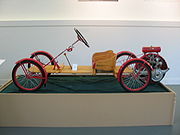
Smith Flyer
Encyclopedia

United States
The United States of America is a federal constitutional republic comprising fifty states and a federal district...
automobile
Automobile
An automobile, autocar, motor car or car is a wheeled motor vehicle used for transporting passengers, which also carries its own engine or motor...
manufactured by the A.O. Smith Company in Milwaukee from 1915 until about 1919 when the manufacturing rights were sold to Briggs & Stratton
Briggs & Stratton
Briggs & Stratton is the world's largest manufacturer of air-cooled gasoline engines primarily for outdoor power equipment. Current production averages 11 million engines per year.-History:...
and it was renamed to Briggs & Stratton Flyer. The Smith Flyer is a small, simple, lightweight, two-seat vehicle with a wooden frame that doubles as the body and as the suspension. A small gasoline engine is mounted on a fifth wheel, or motor wheel, to drive the Flyer. The wheelbase was 62 inches (1575 mm), the wheels were 20 inches (508 mm) in diameter, and the width was 30 inches (762 mm). Since the 5th wheel was directly driven by the engine, the engine was started with the driving wheel lifted slightly in the air, and then when the engine was running smoothly, the driver lowered the engine (by means of a lever) gently to start the forward motion.
The direct drive motor wheel was developed by Arthur William Wall of Birmingham
Birmingham
Birmingham is a city and metropolitan borough in the West Midlands of England. It is the most populous British city outside the capital London, with a population of 1,036,900 , and lies at the heart of the West Midlands conurbation, the second most populous urban area in the United Kingdom with a...
, England
England
England is a country that is part of the United Kingdom. It shares land borders with Scotland to the north and Wales to the west; the Irish Sea is to the north west, the Celtic Sea to the south west, with the North Sea to the east and the English Channel to the south separating it from continental...
, around 1910 to power a bicycle. The concept of attaching the motor directly to the wheel was not new; Ferdinand Porsche
Ferdinand Porsche
Ferdinand Porsche was an Austrian automotive engineer and honorary Doctor of Engineering. He is best known for creating the first hybrid vehicle , the Volkswagen Beetle, and the Mercedes-Benz SS/SSK, as well as the first of many Porsche automobiles...
developed one around 1900, but his motor wheel was electric. The A.O. Smith Corporation of Milwaukee, Wisconsin
Milwaukee, Wisconsin
Milwaukee is the largest city in the U.S. state of Wisconsin, the 28th most populous city in the United States and 39th most populous region in the United States. It is the county seat of Milwaukee County and is located on the southwestern shore of Lake Michigan. According to 2010 census data, the...
, acquired the U.S. manufacturing rights to the Wall motorwheel in 1914 and first produced the motor wheel for use on bicycles, but later added the wooden-framed buckboard
Buckboard
A buckboard is a four-wheeled wagon of simple construction meant to be drawn by a horse or other large animal. The "buckboard" is the front-most board on the wagon that could act as both a footrest for the driver and protection for the driver from the horse's rear hooves in case of a "buck". The...
car that they called the "Smith Motorwheel". In 1919 the manufacturing rights were purchased by the Briggs & Stratton
Briggs & Stratton
Briggs & Stratton is the world's largest manufacturer of air-cooled gasoline engines primarily for outdoor power equipment. Current production averages 11 million engines per year.-History:...
Company, who produced the Motor Wheel and Flyers. They made several improvements in the engine, increasing the bore size, along with a new, all steel connecting rod and flywheel magneto. These improvements increased the power output to 2 horsepower (1.5 kW). Briggs & Stratton marketed the Flyer nationwide, and even started a publication entitled Motor Wheel Age. In 1925, when they sold the rights to the Flyer to Automotive Electric Services Corporation. The Automotive Electric Services continued to produce the Flyer until the supply of engines ran out, then they substituted an electric motor driven by a battery.
Briggs & Stratton kept the motor that had been the heart of the Motor Wheel and adapted it to other applications such as lawn mowers and running small equipment. The Motor Wheel motor was the progenitor of all Briggs & Stratton motors to follow.
Virtually all Flyers were painted red and were known widely as the “Red Bug”. The Flyer is listed in the Guinness Book of Records as the most inexpensive car of all time. The book lists the 1922 Briggs & Stratton Flyer as selling from US$125 to US$150.
A few Smith Flyers still exist in collections around the country, and blueprints for the car are available online.

